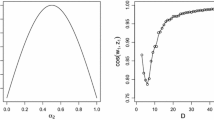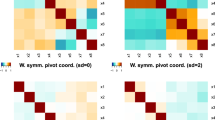Abstract
Even though the logratio methodology provides a range of both generic, mostly exploratory, and purpose-built coordinate representations of compositional data, simple pairwise logratios are preferred by many for multivariate analysis in the geochemical practice, principally because of their simpler interpretation. However, the logratio coordinate systems that incorporate them are predominantly oblique, resulting in both conceptual and practical problems. We propose a new approach, called backwards pivot coordinates, where each pairwise logratio is linked to one orthogonal coordinate system, and these systems are then used together to produce a concise output. In this work, principal component analysis and regression with compositional explanatory variables are used as primary methods to demonstrate the methodological and interpretative advantages of the proposal. In the applied part of this study, sediment compositions from the Jizera River, Czech Republic, were analysed using these techniques through backwards pivot coordinates. This allowed us to discuss grain size control of the element composition of sediments and clearly distinguish anthropogenically contaminated and uncontaminated strata in sediment depth profiles.



Similar content being viewed by others
Availability of data and materials
Data are available from the authors on request.
References
Aitchison J (1982) The statistical analysis of compositional data (with discussion). J R Stat Soc Ser B (Stat Methodol) 44(2):139–177
Aitchison J (1983) Principal component analysis of compositional data. Biometrika 70(1):57–65
Aitchison J (1986) The statistical analysis of compositional data. Chapman & Hall, London (Reprinted in 2003 with additional material by The Blackburn Press)
Aitchison J, Greenacre M (2002) Biplots for compositional data. J R Stat Soc Ser C (Appl Stat) 51(4):375–392
Álvarez-Vázquez MÁ, Hošek M, Elznicová J, Pacina J, Hron K, Fačevicová K, Talská R, Bábek O, Matys Grygar T (2020) Separation of geochemical signals in fluvial sediments: new approaches to grain-size control and anthropogenic contamination. Appl Geochem 123:104791
Bábek O, Matys Grygar T, Faměra M, Hron K, Nováková T, Sedláček J (2015) How to separate the effects of sediment provenance and grain size with statistical rigour? Catena 135:240–253
Billheimer D, Guttorp P, Fagan W (2001) Statistical interpretation of species composition. J Am Stat Assoc 96(456):1205–1214
Bouchez J, Lupker M, Gaillardet J, France-Lanord C, Maurice L (2011) How important is it to integrate riverine suspended sediment chemical composition with depth? Clues from Amazon river depth-profiles. Geochim Cosmochim Acta 75(22):6955–6970
Buccianti A (2013) Is compositional data analysis a way to see beyond the illusion? Comput Geosci 50:165–173
Chen JB, Gaillardet J, Bouchez J, Louvat P, Wang YN (2014) Anthropophile elements in river sediments: overview from the Seine River, France. Geochem Geophys Geosyst 15:4526–4546
Coenders G, Pawlowsky-Glahn V (2020) On interpretations of tests and effect sizes in regression models with a compositional predictor. SORT 44(1):201–220
Egozcue JJ (2009) Reply to “On the Harker variation diagrams;...” by J.A. Cortés. Math Geosci 41(7):829–834
Egozcue JJ, Pawlowsky-Glahn V (2005) Groups of parts and their balances in compositional data analysis. Math Geol 37(7):795–828
Egozcue JJ, Pawlowsky-Glahn V, Mateu-Figueras G, Barceló-Vidal C (2003) Isometric logratio transformations for compositional data analysis. Math Geol 35(3):279–300
Egozcue JJ, Daunis-i Estadella J, Pawlowsky-Glahn V, Hron K, Filzmoser P (2012) Simplicial regression. The normal model. J Appl Probab Stat 6(1–2):87–108
Erb I (2020) Partial correlations in compositional data analysis. Appl Comput Geosci 6:100026
Faměra M, Matys Grygar T, Elznicová J, Grison H (2018) Geochemical normalization of magnetic susceptibility for investigation of floodplain sediments. Environ Earth Sci 77:189
Filzmoser P, Hron K (2008) Outlier detection for compositional data using robust methods. Math Geosci 40(3):233–248
Filzmoser P, Hron K (2019) Comments on: Compositional data: the sample space and its structure. TEST 28(3):639–643
Filzmoser P, Hron K, Reimann C (2009) Principal component analysis for compositional data with outliers. Environmetrics 20:621–632
Filzmoser P, Hron K, Templ M (2012) Discriminant analysis for compositional data and robust parameter estimation. Comput Stat 27(4):585–604
Filzmoser P, Hron K, Templ M (2018) Applied compositional data analysis. Springer series in statistics. Springer, Cham
Fišerová E, Hron K (2011) On interpretation of orthonormal coordinates for compositional data. Math Geosci 43(4):455–468
Greenacre M (2018a) Compositional data in practice. CRC Press, Boca Raton
Greenacre M (2018b) Variable selection in compositional data analysis using pairwise logratios. Math Geosci 51:649–682
Greenacre M (2019) Comments on: Compositional data: the sample space and its structure. TEST 28(3):644–652
Grosbois C, Meybeck M, Lestel L, Lefévre I, Moatar F (2012) Severe and contrasted polymetallic contamination patterns (1900–2009) in the Loire River sediments (France). Sci Total Environ 435:290–305
Guo YL, Yang SY, Su N, Li C, Yin P, Wang ZB (2018) Revisiting the effects of hydrodynamic sorting and sedimentary recycling on chemical weathering indices. Geochim Cosmochim Acta 227:48–63
Hron K, Filzmoser P, Thompson K (2012) Linear regression with compositional explanatory variables. J Appl Stat 39(5):1115–1128
Hron K, Filzmoser P, de Caritat P, Fišerová E, Gardlo A (2017) Weighted pivot coordinates for compositional data and their application to geochemical mapping. Math Geosci 49(6):797–814
Johnson R, Wichern D (2007) Applied multivariate statistical analysis, 6th edn. Prentice Hall, Upper Saddle River
Kalivodová A, Hron K, Filzmoser P, Najdekr L, Janečková H, Adam T (2015) PLS-DA for compositional data with application to metabolomics. J Chemom 29(1):21–28
Kynčlová P, Filzmoser P, Hron K (2016) Compositional biplots including external non-compositional variables. Statistics 50(5):1132–1148
Maechler M, Rousseeuw P, Croux C, Todorov V, Ruckstuhl A, Salibian-Barrera M, Verbeke T, Koller M, Conceicao E, di Palma M (2020) robustbase: basic robust statistics. R package version 0.93-6
Maronna R, Martin D, Yohai V (2006) Robust statistics: theory and methods. Wiley, Chichester
Martín-Fernández J (2019) Comments on: Compositional data: the sample space and its structure. TEST 28(3):653–657
Matys Grygar T, Popelka J (2016) Revisiting geochemical methods of distinguishing natural concentrations and pollution by risk elements in fluvial sediments. J Geochem Explor 170:39–57
Matys Grygar T, Nováková T, Bábek O, Elznicová J, Vadinová N (2013) Robust assessment of moderate heavy metal contamination levels in floodplain sediments: A case study on the Jizera River, Czech Republic. Sci Total Environ 452:233–245
Matys Grygar T, Elznicová J, Bábek O, Hošek M, Engel Z, Kiss T (2014) Obtaining isochrones from pollution signals in a fluvial sediment record: a case study in a uranium-polluted floodplain of the Ploučnice River, Czech Republic. Appl Geochem 48:1–15
Matys Grygar T, Hošek M, Pacina J, Štojdl J, Bábek O, Sedláček J, Hron K, Talská R, Křiženecká S, Tolaszová J (2018) Changes in the geochemistry of fluvial sediments after dam construction (the Chrudimka River, the Czech Republic). Appl Geochem 98:94–108
Matys Grygar T, Mach K, Martinez M (2019) Checklist for the use of potassium concentrations in siliciclastic sediments as paleoenvironmental archives. Sed Geol 382:75–84
McGregor DE, Palarea-Albaladejo J, Dall PM, Hron K, Chastin SF (2020) Cox regression survival analysis with compositional covariates: application to modelling mortality risk from 24-h physical activity patterns. Stat Methods Med Res 29(5):1447–1465
Müller I, Hron K, Fišerová E, Šmahaj J, Cakirpaloglu P, Vančáková J (2018) Interpretation of compositional regression with application to time budget analysis. Austrian J Stat 47(2):3–19
Palarea-Albaladejo J, Martín-Fernández JA, Soto JA (2012) Dealing with distances and transformations for fuzzy c-means clustering of compositional data. J Classif 29(2):144–169
Pawlowsky-Glahn V, Buccianti A (eds) (2011) Compositional data analysis: theory and applications. Wiley, Chichester
Pawlowsky-Glahn V, Egozcue JJ (2001) Geometric approach to statistical analysis on the simplex. Stochastic Environmental Research and Risk Assessment (SERRA) 15(5):384–398
Pawlowsky-Glahn V, Egozcue JJ, Tolosana-Delgado R (2015) Modeling and analysis of compositional data. Wiley, Chichester
Reid M, Spencer KL (2009) Use of principal components analysis (PCA) on estuarine sediment datasets: The effect of data pre-treatment. Environ Pollut 157:2281–2275
Sohn M, Li H (2019) Compositional mediation analysis for microbiome studies. Ann Appl Stat 13(1):661–681
Thomas CW, Aitchison J (2005) Compositional data analysis of geological variability and process: a case study. Math Geol 37(7):753–772
Thomas C, Aitchison J (2006) Log-ratios and geochemical discrimination of Scottish Dalradian limestones: a case study. In: Buccianti A, Mateu-Figueras G, Pawlowsky-Glahn V (eds) Compositional data analysis in the geosciences: from theory to practice. Geological Society, London, pp 25–41
Tolosana-Delgado R, van den Boogaart K (2011) Linear models with compositions in R. In: Pawlowsky-Glahn V, Buccianti A (eds) Compositional data analysis: theory and applications. Wiley, Chichester, pp 356–371
Tolosana-Delgado R, Talebi H, Khodadadzadeh M, Van den Boogaart K (2019) On machine learning algorithms and compositional data. In: Ortego M (ed) Proceedings of the 8th international workshop on compositional data analysis (CoDaWork2019): Terrassa, 3–8 June, 2019, Universitat Politècnica de Catalunya-BarcelonaTECH, pp 172–175
van den Boogaart K, Tolosana-Delgado R (2013) Analyzing compositional data with R. Springer, Heidelberg
van den Boogaart K, Filzmoser P, Hron K, Templ M, Tolosana-Delgado R (2020) Classical and robust regression analysis with compositional data. Math Geosci 1–36 https://doi.org/10.1007/s11004-020-09895-w
Vencálek O, Hron L, Filzmoser P (2020) A comparison of generalised linear models and compositional models for ordered categorical data. Stat Model 20(3):249–273
von Eynatten H, Tolosana-Delgado R, Karius V, Bachmann K, Caracciolo L (2016) Sediment generation in humid Mediterranean setting: grain-size and source-rock control on sediment geochemistry and mineralogy (Sila Massif, Calabria). Sed Geol 336:68–80
Acknowledgements
The authors thank to Štěpánka Tůmová (IIC Řež) for providing the digital terrain model of the sampling site. KH, PF, MF and TMG gratefully acknowledge the support of the Czech Science Foundation GA19-01768S. GC and JPA were supported by the Spanish Ministry of Science, Innovation and Universities under the project CODAMET (RTI2018-095518-B-C21, 2019-2021).
Author information
Authors and Affiliations
Contributions
KH, GC and TMG conceived this research and designed the experiments; TMG provided the geochemical dataset and interpretations; GC and PF performed the experiments and analysis; KH and GC wrote the first draft of the paper and KH, GC, TMG, PF and JPA all participated in the revisions of it; MF planned and performed sediment sampling, which represented the studied floodplain, and supervised sediment analyses.
Corresponding author
Ethics declarations
Conflict of interest
The authors declare that they have no conflict of interest.
Rights and permissions
About this article
Cite this article
Hron, K., Coenders, G., Filzmoser, P. et al. Analysing Pairwise Logratios Revisited. Math Geosci 53, 1643–1666 (2021). https://doi.org/10.1007/s11004-021-09938-w
Received:
Accepted:
Published:
Issue Date:
DOI: https://doi.org/10.1007/s11004-021-09938-w




